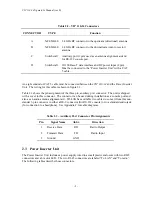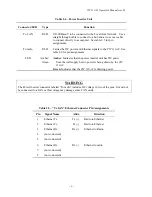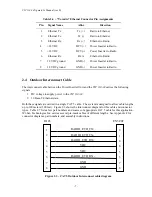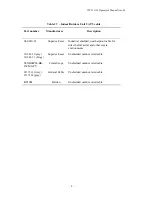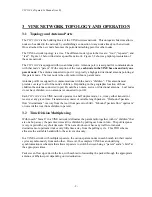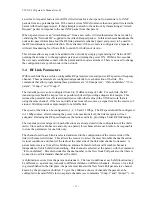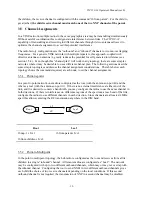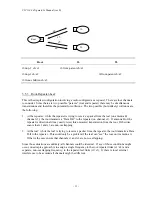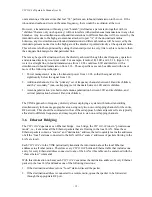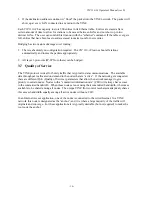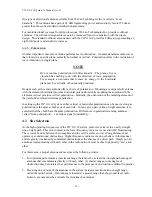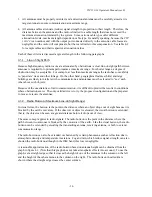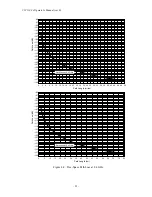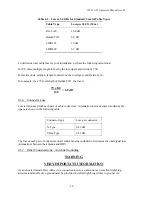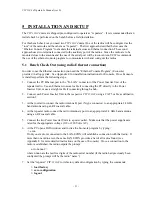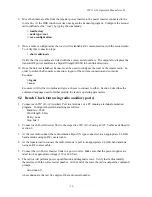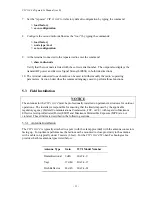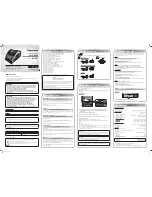
VIP 110-24
Operator’s Manual (rev E)
- 19 -
One type of directional antenna available from Wi-Lan Technologies Inc. is called a “semi
parabolic”. This antenna has a gain of 24 dBi, representing power and sensitivity levels 256 times
greater than those of a standard omnidirectional antenna.
For omnidirectional coverage from fixed locations, Wi-Lan Technologies Inc. provides collinear
antennas. The collinear design achieves gain by increased focus in comparison with the dipole
design. The standard collinear antenna used with the
VIP 110-24
provides 9 dBi gain, representing an
eight-fold power and sensitivity increase.
4.2.3
Polarization
Another important concept for antenna performance is polarization. An antenna radiates radio waves
that vibrate in a specific plane, normally horizontal or vertical. Polarization refers to the restriction of
wave vibration to a single plane.
NOTE
Do not confuse polarization with directionality. The plane of wave
vibration has nothing to do with the direction of wave propagation.
For example, an antenna that focuses its energy in the horizontal
plane may be vertically or horizontally polarized.
Designs such as the semi parabolic offer a choice of polarization. Mounting a semi parabolic antenna
with the elements horizontal provides horizontal polarization, while mounting the antenna with the
elements vertical provides vertical polarization. Similarly, the orientation of the radiating element of
the parabolic antenna determines polarization.
In setting up the
VIP 110-24
system, either vertical or horizontal polarization can be used, as long as
polarization is the same at both ends of each link. For any given pair of line-of-sight antennas, it is
essential that they both have the same polarization. Differences in polarization among antennas –
called “cross-polarization” – can reduce signal considerably.
4.3
Site Selection
At the high operating frequencies of the
VIP 110-24
system, radio waves travel in a nearly straight
line-of-sight path. This is in contrast to the lower-frequency radio waves used for AM broadcasting.
These waves bounce between the ionosphere and the earth’s surface to travel long distances and
operate over and around obstructions. Higher-frequency radio waves do not behave in this manner
and are greatly weakened by substantial obstructions or the absence of a direct path. Simply put, all
antennas communicating with each other in the radio network must be able to physically “see” each
other.
For this reason, a proper antenna site must meet the following criteria:
1.
For optimum performance at maximum range, there must be a clear line-of-sight path among all
antennas that communicate directly with each other. At shorter ranges, some degree of
obstruction may be tolerated, but performance in the presence of obstruction is difficult to predict.
2.
Elevating one or more of the antennas in the system increases maximum line-of-sight range,
called the radio horizon. If antennas are located at a greater range than the ground-level radio
horizon, a means must be available for elevating the antennas.
Summary of Contents for VIP 110-24
Page 2: ......
Page 5: ...VIP 110 24 Operator s Manual rev E iv...
Page 37: ...VIP 110 24 Operator s Manual rev E 30...
Page 73: ...VIP 110 24 Operator s Manual rev E 66...
Page 89: ...VIP 110 24 Operator s Manual rev E 82...
Page 91: ...VIP 110 24 Operator s Manual rev E 84...

